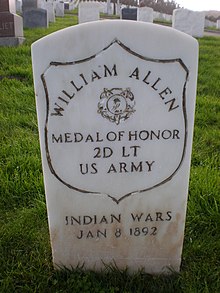William Allen (c. 1845 – January 8, 1882) was a U.S. Army soldier who fought during the Indian Wars in the post-American Civil War period. Serving under Lieutenant Colonel George Crook, he participated in expeditions against the Apache in the Arizona Territory throughout the 1870s. He was one of four men who received the Medal of Honor for the Battle of Turret Peak against the Yavapai Apaches in 1873.
William Allen | |
|---|---|
 Allen's headstone at San Francisco National Cemetery | |
| Born | c. 1845 Brightstown, New York or Philadelphia, Pennsylvania |
| Died | January 8, 1882 (aged 36–37) Fort Mojave, Arizona |
| Place of burial | |
| Allegiance | United States |
| Service | United States Army |
| Years of service | 1864–1868, 1870–1882 |
| Rank | First Lieutenant |
| Unit | 29th Pennsylvania Volunteers 23rd U.S. Infantry 12th U. S. Infantry |
| Battles / wars | American Civil War Indian Wars |
| Awards | Medal of Honor |
Biography
editBorn either in Brightstown, New York[1][2] or Philadelphia, Pennsylvania,[3][4] Allen enlisted as a private into the 29th Pennsylvania Volunteers on August 15, 1864, and served through Sherman's March to the Sea, until June 7, 1865. In August 1865, he enlisted in the Regular Army at Lansingburgh, New York and was assigned to the 23rd U.S. Infantry.[3][5] Eventually reaching the rank of first sergeant, he was part of the Lieutenant Colonel George Crook's campaign against the Apache during the early 1870s. On March 27, 1873, he took part in a major engagement against the Yavapai Apaches at Turret Peak, Arizona, only 20 miles south of Camp Verde. He, along with Captain George M. Randall, led a successful surprise attack and was awarded the Medal of Honor for "gallantry in action".[6][7] He officially received the medal on April 12, 1875, two years after the battle.[2]
In October 1873, Allen was commissioned a Second Lieutenant in the 12th U. S. Infantry, and was promoted to First Lieutenant in December 1880. He died of "inflammation of the bowel" at Fort Mojave, Arizona on January 8, 1882, although his tombstone places the date exactly ten years later in 1892.[8] His remains were eventually buried in the San Francisco National Cemetery.[4]
See also
editReferences
edit- This article incorporates public domain material from websites or documents of the United States Army Center of Military History.
- ^ Thrapp, Dan L. (1991). Encyclopedia of Frontier Biography In Three Volumes Volume 1, A–F. Lincoln, Nebraska: University of Nebraska Press. p. 16. ISBN 0-8032-9418-2.
- ^ a b "Medal of Honor recipients: Indian Wars Period - William Allen". United States Army Center of Military History. July 16, 2007. Archived from the original on August 3, 2013. Retrieved March 31, 2008.
- ^ a b Heitman, Francis B. (1903). Historical Register and Dictionary of the United States Army From Its Organization September 29, 1789 To March 2, 1903. Washington, DC: Government Printing Office. pp. 160. Retrieved April 21, 2008.
- ^ a b Altshuler, Constance Wynn (1991). Cavalry Yellow and Infantry Blue: Army Officers in Arizona Between 1851 and 1886. Tucson, Arizona: Arizona Historical Society. p. 7. ISBN 0-910037-28-0.
- ^ Powell, William H. (1900). List of Officers of the Army of the United States From 1779 to 1900. New York: L R Hamersly. pp. 159. Retrieved April 21, 2008.
- ^ Field, Ron. US Infantry in the Indian Wars, 1865-91. Westminster, Maryland: Osprey Publishing, 2007. (pg. 17) ISBN 1-84176-905-3
- ^ "MOH Recipient William Allen". Homeofheroes.com. 2003. Retrieved June 27, 2008.
- ^ vconline.org.uk